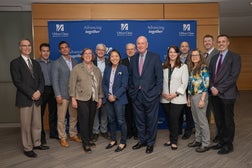Money lies at the root of health-care industry pressures

Consumers often struggle to comprehend how medical bills quickly add up to astronomical amounts, and lament layoffs and budget cuts at large hospitals that generated millions of dollars in revenue. But those on the business side of health care know that the big dollar figures don't necessarily add up to much, especially as reimbursements shrink under health care reform, while state benchmarks for lower health care spending must be met. These pressures have reshaped the industry and will result in a drastic change in health care delivery. Here's how it could play out in the coming year.
1. UMass Memorial Health Care as HMO?
If 2014 was a year of transitioning for UMass Memorial Health Care, the region's largest health care system, 2015 will be a year of repositioning. CEO Eric Dickson said that while a projected year-end operating surplus of $29 million was good news after the system finished the previous year with a $57 million operating loss, the more important indicator of future success is UMMHC's ability to execute on plans to make it viable in the future. One way the system will do that is by taking on risk for its patient population, much like an insurer does. On Jan. 1, UMMHC will begin taking on risk for Medicare patients through its new accountable care organization. Meanwhile, Dickson said the system will continue to manage the risk of patients covered by Blue Cross Blue Shield insurance through an agreement with the insurer, and will continue to align with other health maintenance organizations (HMOs) to manage risk.
That, Dickson said, is the key to survival, as providers have to manage costs closely because of a transition to a global payment system in which providers are paid on a per-patient basis, rather than for each service rendered.
“That's the future, for us to be working directly with employers,” Dickson said.
2. A continued plea for more NIH funding
The National Institutes for Health, the nation's medical research agency, is the lifeblood of academic research institutions, which rely on annual awards to their scientists to finance new clinical studies that lay the foundation for treatments that could spare future generations from today's fatal diseases. Following automatic budget cuts under sequestration in 2013, scientists have had to compete harder for those dollars, UMass Medical School Chancellor Michael Collins said. Today, Collins added, funding levels are about where they were in 2002.
While UMMS has been able to maintain its grant funding through the sequestration, flat levels provide little breathing room compared with years that NIH grants received a boost from President Obama's economic stimulus packages. For 2015, Congress approved a virtually flat $30 billion NIH budget, which was in line with Collins' expectations.
“When I talk to our scientists right now, there's a level of concern, anxiety, apprehension,” Collins said.
3. More consolidation of providers
Local health care officials have speculated that Massachusetts is moving toward a system dominated by a handful of large health care organizations that can manage risk, as Dickson discussed, as well as provide health care to large populations. With that on the horizon, consolidation to help providers gain strength through growth will likely continue in 2015.
Two Central Massachusetts physician groups, Reliant Medical Group and Southboro Medical Associates, are set to merge Jan. 1, and it's more likely than not that other organizations will find similar opportunities.
4. A repeal of the federal medical device tax?
Repealing the medical device tax may be something members of Congress will actually agree on. Critics and members of the medical device industry say the tax, which would raise an estimated $30 billion over 10 years under the Affordable Care Act, is a job killer. An industry group, Advanced Medical Technology Association, estimates 30,000 jobs were lost in 2013, when the tax took effect.
The move to do away with the 2.3-percent levy on companies that sell medical devices and equipment is a top priority of Republican lawmakers, who took control of both the House and the Senate in the November elections. But a repeal has bipartisan support, with Democratic Massachusetts Sen. Elizabeth Warren among supporters.
5. An increase in “telemedicine”
Telemedicine refers to the remote monitoring of patients by health care providers. Its role is becoming increasingly important as providers work to move patient care to the lowest cost setting. Through two-way video, email and smart phones, lower-cost community hospitals can deliver health care to patients who otherwise might be transferred to larger, more expense hospitals for treatment.
Telemedicine is already happening locally, with neurologists at Massachusetts General Hospital partnering with Harrington Hospital in Webster and Southbridge to monitor stroke patients.
With an eye on efficiency, more providers are likely to seize opportunities to use telemedicine.













0 Comments